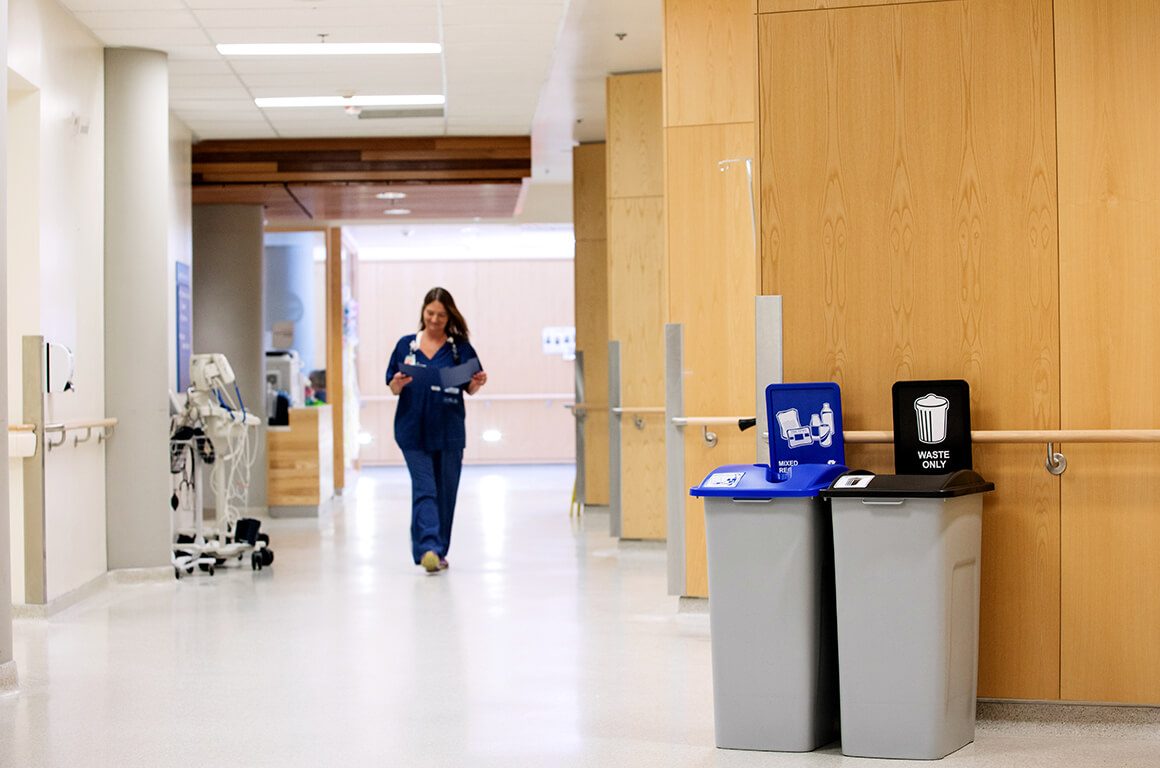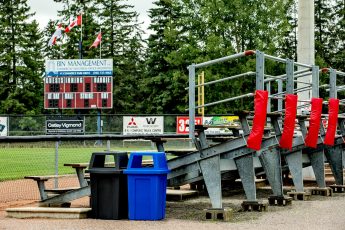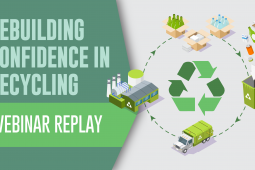For more information on how to build an exceptional recycling program for your healthcare facility, click here.
We’ve been building exceptional healthcare recycling & waste management programs for over 35 years. Here’s 10 key secrets we’ve unearthed that’ll help build the collection program you’ve always wanted for your healthcare facility and save you money in the process.
Let’s start with the facts.
Hospitals and ambulatory healthcare facilities are chief consumers of resources, and they contribute immensely to the generation of waste:
- American hospitals generate nearly 6,600 tons of waste everyday.
- In a 2010 survey, 114 of the group’s member hospitals reported generating an average of 33.8 pounds of waste per day, per staffed bed.
- The World Health Organization estimates that 85% of total waste created in healthcare facilities is general, non-hazardous waste, and only 15% is considered hazardous material.
Healthcare facilities pose the greatest opportunity to make a large, positive impact on diversion rates in a community. In the current climate, it’s essential for every healthcare facility to have an effective waste management program in place with a strong focus on recycling the estimated 85% standard municipal solid waste generated by each facility.
With proof in the statistics above, ineffective healthcare collection programs tend to generate a lot of waste, require regular maintenance and expensive waste disposal. Bearing these things in mind, let’s take a look at 10 key ways to enhance the effectiveness of your healthcare waste management program.
-
- Always begin with a preliminary waste audit to categorize and quantify your healthcare waste
Step one of building a successful waste management program for any industry begins with identifying and categorizing the types and quantity of waste produced by every segment of your grounds. Use a map of your healthcare facility’s grounds to identify key areas (i.e waiting rooms, day rooms, patient rooms, emergency rooms, operating rooms, etc.) and begin to identify what types of waste is being generated in each area.
For example, a typical hospital’s solid waste can be broken down into the follow streams: 54% is comprised of paper and cardboard, 18% organics, 15% plastics, 3% metal, and 2% glass. Each of these streams can be separated into custom, color-coded bins for easy stream identification and simple waste disposal that minimizes contamination.
- Build a Green Team
How much time does your healthcare facilities management team have to spare for sustainability initiatives?
If the answer is less than you would like, a green team can be the most valuable ally in your quest for building an effective recycling program.
A Green Team is a small group of employees whose combined goal is to educate, empower and inspire colleagues to establish and promote environmentally sustainable practices within their organization. Every new initiative needs a full launch campaign and a group of influencers that will help build the momentum of your program. Without a green team, it will be very difficult to get your new healthcare waste management program off the ground.
To set up your green champions for long term success, make sure this group has formal oversight, tools for measurement and verification, and a clear mission.
- Communicating your program to your visitors is essential
Because your visitors don’t spend every day of the year at your healthcare facility, they may not be aware of how your recycling & waste management program operates. This means you have seconds to educate your visitors about the materials you’re collecting and how they’re separated into specific streams.Start with your recycling stations!
Make sure your recycling & waste labels on your containers are clear and easy to understand. Many healthcare facilities have people visiting from all parts of the globe that speak many different languages and don’t have recycling at the top of their minds. Use impactful graphics with clearly identifiable images of typical items that can be discarded and standardize these graphics, so they’re consistent throughout your healthcare facility.
Get everyone on board with your program by telling everyone about it! Communicate and educate staff about the healthcare facility’s goals and the sustainability initiatives so they can pass the knowledge onto your visitors.
- Modify your operational habits
The daily operation of your hospital provides you with an excellent testing ground for some of the waste management techniques.
Reducing the amount of waste begins with making small modifications. Here’s some examples to spark your creativity:
- Share magazines and journals between departments to reduce multiple subscriptions.
- Use washable items, such as linens, bed pads, gowns, etc. Set up a volunteer program to recycle used blankets, mattress pads, and quilts into potholders.
- For administration: Make double-sided copies. Keep hardcopy memo distribution to a minimum. Use email instead.
- Avoid paper products other than toilet paper in the bathrooms.
- Use reusables in patient rooms versus disposables (bed pans, water pitchers etc.)
- Focus on food waste
The EPA estimates that U.S. hospitals generate about 170,000 tons of food waste annually, making up a large portion of their solid-waste. Approximately 50% of total food placed at patient’s bedside ends up as waste; in 2010, this resulted in $45 million dollars in wasted food, not accounting for service and labour costs to produce and prepare the food itself
Food recovery programs like composting is a great way to reduce waste from food loss and divert the scraps out of the waste-stream. Add an organics/compost stream to your standardized recycling stations (especially the ones located near cafeterias) to see a large spike in your food waste recovery rate.
- Ditch single-use plastics
In today’s world, sustainability means more than simply recycling a product. It means ensuring that a product has a second life through redesign and reentry. A US study found that a single hysterectomy produced 20 pounds of waste in plastic, packaging, drapes, and so on (bio-waste was not included). The problem may be getting worse – due to patient safety, cost and convenience, more and more clinical instruments and supplies are being marked as “single use” and thrown out. At Toronto Western Hospital, meanwhile, a neurosurgery team led by Dr. Michael Tymianski was able to save hundreds of thousands by making the switch to reusables.
- Re-evaluate Disposal Habits
Not long ago, waste removal was mostly built around collecting co-mingled materials and sending the waste to landfills, where it was incinerated or compacted by waste disposal companies. These days, however, you can take an active role in managing part of the process.
As aforementioned, food waste is considered a largest waste stream in a healthcare facility and fortunately there’s a new crop of haulers that focus solely on organics/compost collection that will gladly collect your food waste, often at reduced costs. And if that’s not an option, you can always invest in food composters to reduce the binned waste generated by food leftovers.
- Choose the right recycling stations
There’s a plethora of factors you need to consider when purchasing containers to suit each space around your grounds—too many to cover in this blog! However, as a start, if you want your healthcare recycling & waste program to be successful, it’s imperative that you choose containers that keep all of the collection streams together, regardless of their location across your grounds.
For example, if there isn’t a recycling or compost stream directly next to the trash stream, people just end up tossing all their waste in the most convenient bin—the closest one. This leads to enormous amounts of contamination, which can derail your sustainability goals due to your recycling and compost often ending up in the landfill rather than being properly sorted at your Material Recovery Facilities (MRF).
Quickly, some other things to consider when choose the right recycling & waste station are:
- Placement
- Antimicrobial capabilities
- Climate
- Capacity
- Restrictive Openings
- Signage & Label Customization Capabilities
- Set sustainability standards for your vendors
You should have complete control of the high-quantity materials entering your facilities (i.e single-use plastics, single-use devices, equipment packaging, food packaging, etc.). Communicating standards to your vendors and choosing more sustainable alternatives will have a large impact on the quantity of waste and therefore your disposal costs.
- Track, track, track
Be sure to keep track of the progress and, when possible, quantify this progress to show the return on the investments made. Dignity Health — the fifth largest health system in the nation, comprising 39 hospitals across California, Arizona and Nevada — has a long history of implementing innovative sustainability efforts, guided by the belief that a healthy environment leads to healthy people. Here’s a quote from their Vice President of Corporate Responsibility:
In our first year of Blue Renew, we recycled over 213,000 pounds of sterilization wrap. The following year, the staff challenged itself to do even better and engaged in competition across hospitals to increase the amount of wrap recycled. The results speak for themselves: at the end of 2017, we collectively recycled 250,000 pounds of wrap. In 2018, we anticipate recycling over 125 tons of wrap collectively across the network.
- Always begin with a preliminary waste audit to categorize and quantify your healthcare waste
Give your healthcare waste management program a boost by taking advantage of these 10 industry secrets! Once you’ve launched your healthcare recycling & waste management program, you’ll start to see many more areas for improvement. These minor or major improvements will continue to increase your diversion rate and positive impact on the environment, reduce your costs and ultimately enhance your healthcare facility’s image amongst the community.
Need help getting started? Contact us to chat with our Healthcare Waste Management Specialists for more direction on where to begin your journey to waste management greatness.





















